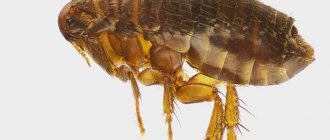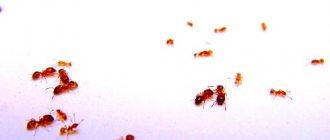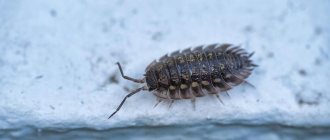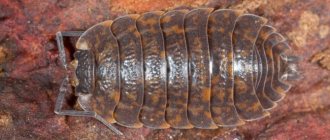- What does a centipede flycatcher look like, what kind of “beast” is it?
- How do flycatchers hunt and who do they eat?
- Centipedes in the apartment: reasons for their appearance
- Is the house centipede dangerous or not?
- How to drive away centipedes
- Harmless ways to get rid of house scolopendra
- Chemical control agents
- Centipede flytrap and traps
We are not afraid of flies, spiders, cockroaches, because we see these insects more often and are familiar with the behavior. The common house centipede flycatcher is a cautious insect, hunts at night, is rare, so the frightening appearance of the alien frightens and arouses mistrust. In addition, apartment residents do not know the habits of the unfamiliar creature or how to behave with it.
Insect centipede - appearance, habitat, behavioral features
What does a centipede look like?
The body length of the house centipede
is usually about 4–6 cm. The color of the insect varies from yellow-gray to brown. There are three stripes along the back; they come in purple or blue. The centipede has compound eyes, thanks to which it has excellent vision. On the sides of the head there are small antennae, consisting of a large number of segments; they react to changes in air temperature and thereby help the insect navigate in finding the safest places.
The body consists of 15 segments that are capable of supporting the body in weight. The flycatcher has many legs, their length increases as they approach the tail. This structure of the legs allows it to run quickly at speeds of up to 40 cm per second. The number of limbs and segments in millipedes increases as they grow up to 15 pairs. Last pair of legs
It can be so long that it can exceed the size of the insect's body. The first pair of forelimbs in the process of evolution began to represent jaw processes, which greatly help the centipede in hunting.
Where does the centipede live?
These insects live in many countries
temperate climate: Northern Africa, Southern Europe, Middle East. In Russia, the centipede is found in the southern regions, the Volga region, and the middle zone. Usually, the house centipede can be found under stones in the forest, near the roots of trees, in fallen leaves, where it is wet and damp, since they need a moist environment for full life and successful reproduction.
They may appear in a house or apartment in the fall, when it gets cold outside. In winter, centipedes hibernate, and by spring they wake up and become active. In southern countries, this type of insect is treated very well, as they are able to help people destroy pests.
In human habitation
centipedes prefer to live:
- In dark basements.
- In bathrooms and toilets.
- In places with high humidity.
Common flycatchers are predators. They can eat insects that live near them. A centipede living in a person’s house can even be useful, as it helps get rid of cockroaches, flies, spiders, and fleas by feeding on them. Having noticed prey, the flycatcher attacks it, then bites it, injecting poison into the victim’s body, and after that it begins to eat. House centipedes are able to live permanently in people's homes, bringing them only benefits.
Despite this, many are afraid of this insect and believe that the centipede can bite. Fortunately, the venom of the house centipede is dangerous only for small pests, and it does not affect human health in any way. Only in case of individual intolerance to poison
possibly a manifestation of an allergic reaction. Flycatchers bite in self-defense and in very rare cases. They prefer to hide from people, avoiding contact with them.
If you are bitten by a centipede, here's what to do:
- Be sure to disinfect the bite site with hydrogen peroxide or iodine.
- If the wound is swollen and a burning sensation is felt around it, you should apply a cold compress and hold it until the unpleasant symptoms disappear.
- If the pain is severe, you should take painkillers and antihistamines.
Description of the insect
Name: Centipedes Lat.:
MyriapodaKingdom: Animals - Animalia Phylum: Arthropods - Arthropoda
| Habitats: | damp warm places |
| Dangerous for: | small insects |
| Attitude towards people: | harmless, do not harm |
Millipedes are a superclass of invertebrates, which includes about 12 tons of species. There are representatives up to 35 cm in size (giant scolopendra).
Centipedes are still definitively defined in the system.
Centipede.
They are considered in several options:
- close relatives of insects;
- representatives of crustaceans;
- close to chelicerates.
The structure of centipedes
Body
The body consists of a head and a torso. It is all segmented, separated by particles. The head has antennae and jaws. The first limbs are often reduced and are oral organs.
Segments
The body is not divided into sections. Segmentation can be clearly expressed, but it can also be absent. There are also paired segments, it all depends on the species.
Limbs
The legs are simple walking, the number may vary depending on the type. There is always a claw at the tip.
Back
Millipedes are covered with a cuticle made of chitin, which is secreted from the hypodermal epithelium. Beneath it are glands that are responsible for secretion, which repels predators.
Centipede nutrition
Predatory centipedes are of great benefit. They help people fight those who cause harm:
- lice;
- fleas;
- ants;
- cockroaches;
- slugs;
- larvae;
- worms;
- bedbugs;
- caterpillars.
Hunting takes place at night. The centipede just sits and waits for prey, when it appears, it actively attacks, bites to paralyze with poison. This way a flycatcher can catch several victims and hold them with a large number of paws.
Development of centipedes
Centipede with eggs.
All centipedes hatch from eggs. It is large in size with a lot of yolk. Further development can be of two types:
- When an individual is born, it is already fully formed, like the mother’s organism, and only grows throughout its life.
- The animal appears with an incomplete number of segments, but over several molts they are formed.
Preventive measures
The appearance of centipedes in an apartment indicates that, in addition to them, harmful insects have appeared in the home, but for some reason the owners of the apartment do not react to this fact
In addition, it is advisable to pay attention to the microclimate in the apartment and get rid of high humidity, especially in the toilet and bathroom, as well as in the kitchen. To prevent creatures that do not belong in your apartment from entering your apartment, it is better to carry out preventive measures in a timely manner that could have a negative effect on insects
For example:
Fight various insects that are part of the flycatcher's diet. She prefers to eat flies, cockroaches and ants. Repair water supply and sewerage systems, eliminating water leaks. If the apartment is damp, then flycatchers will visit the apartment from time to time. Make sure that there are no wet rags left anywhere, especially in the kitchen or bathroom. Dry towels regularly and constantly. If fungus appears in the apartment, it means the apartment is damp. If there is no fungus, then the apartment has a normal microclimate. After bathing in the bathroom, be sure to open windows and doors for ventilation, otherwise condensation may appear. Monitor the condition of the attic and basement, notifying the relevant services, which must promptly respond to comments from residents of multi-story buildings. Check that there are no gaps in the floor, around baseboards, trim, and under window sills
When cracks appear, they must be sealed immediately with sealant. Regularly carry out general cleaning of the apartment, paying special attention to problem areas, as well as promptly remove garbage and get rid of moisture.
This is why you should not squash centipedes in your home!
Watch this video on YouTube
Are centipedes harmful to humans?
In fact, apart from its terrifying appearance, the centipede is absolutely safe for apartment residents and for pets and other pets. As a rule, the flycatcher comes out to hunt at night, so many owners do not even suspect the existence of this insect in their home. If you do not try to pick it up (even in this case the flycatcher will not bite a person), then this may not end very pleasantly, since there is poison on the insect’s legs. This can lead to redness of the skin. To get rid of discomfort, just place your hand under a stream of cold water. Pets do not suffer in any way from such a neighborhood. And a person, if he does not do anything unnecessary or unreasonable, cannot suffer either.
Lifestyle of centipedes
Millipedes are generalist predators, meaning they are able to feed on a wide range of available food. They find prey mainly using their antennae. Small species eat insects, but the giant Amazon centipede is the largest of its relatives, and it can attack mice, frogs, birds, spiders and lizards.
Centipedes are predominantly nocturnal. But research has shown that the Strigamia chinophila species prefers to be diurnal. They protect themselves from predators due to the fact that they can develop good speed.
Centipedes prefer damp environments.
Centipedes and people
Hand centipede.
In search of shelter, an insect often ends up in a home, especially if there are suitable conditions for it and enough food. But they do not directly harm people.
The pest feeds on other insects. The centipede does not carry diseases, does not feed on human food, does not damage furniture and supplies, and is not a direct threat. But this does not mean that you can take them with your hands. Most representatives of centipedes bite and quite unpleasantly.
Some people keep centipedes as exotic pets. Most often they choose those who feed on wood scraps and vegetables. But there are also predators. They are housed in special terrariums with a lid.
What does a flycatcher look like and where does it live?
The adult insect has an elongated, flattened body consisting of 15 segments. For each segment there is one pair of legs, the length of which increases from the head to the tail. The last pair of legs are so elongated that they look more like antennae (can be confused with the head). Due to the large number of long thin legs, scutigera looks like a hairy or shaggy centipede.
The first pair of legs are transformed into jaws, with which the centipede grabs prey and defends itself from enemies. When hunting, flycatchers inject poison into the body of the victim and then eat it. Flycatchers have good eyesight and a movement speed of up to 40 cm/sec. The antennae are whip-like, very long. The color is yellowish-gray or brownish, with three stripes along the body.
The flycatcher lives 3-7 years, growing up to 6 cm. You can distinguish an adult insect from a young one by the number of legs. The centipede that emerges from the egg has only 4 pairs of them. The number of legs increases after each molt, eventually reaching 15 pairs.
The range of flycatchers covers the distance from Southern Europe to North Africa. On the territory of Russia, it lives in the Black Earth Region, the Caucasus, Crimea and the Volga region.
Centipede flytrap and traps
Trap boxes help, but rarely. They need to be placed on the floor; insects and centipedes crawl in and stay there.
Adhesive tapes will not bring success. The centipede flycatcher will come off without sparing the remaining legs, which will later grow back.
When all else fails, they resort to the services of professionals to carry out disinfestation with chemical agents. After this, you need to leave the apartment for a walk for 4-5 hours, and when you return, open the windows for ventilation. Do not wash the floor for 2-3 days.
How to get rid of centipedes in the house?
The first thing that comes to mind when you see such a “miracle” in your home is to slap it with the first object you come across. Most often this becomes a slipper. But it is worth considering that the centipede is capable of restoring and regrow damaged parts of the body if it is not completely killed. It would be much more humane to catch a flycatcher in a jar and release it outside when it gets warmer.
This method is suitable if one or a pair of centipedes accidentally appeared in the house. If they have occupied the home thoroughly, then it is better to resort to more radical methods. Moreover, it is not necessary to use special drugs or toxic substances. Folk remedies are no less effective.
Is the house centipede dangerous or not?
The flycatcher does not harm humans. However, it should not be touched or frightened, because the centipede flytrap bites, however, only for the purpose of protection. The appearance of the centipede is frightening - the number of legs, long moving mustaches and lightning-fast movement.
Also, this arthropod does not harm furniture, wallpaper and other objects in human housing. Night hunting of creatures eliminates encounters and sometimes residents do not even know that centipedes live in the apartment.
If a bite occurs, which is unlikely, the skin turns red and a slight burning sensation is felt - cold water and hydrogen peroxide will help.
Centipede in the house? 5 Easy Steps to Kill Millipedes
To begin with, deprive the centipedes of their food supply and places to live. If your home is messy and infested with small insects, then they will definitely attract these freaks. In addition, the abundance of damp, cluttered and uncleaned places will allow them to multiply and reproduce with enviable regularity. Regularly ventilate the bathroom and monitor the humidity in the basements. In a dry atmosphere, centipedes die on their own: their shell does not retain moisture and they die from dehydration. To solve the problem even on the approaches to your home, be sure to use sealant
Seal and caulk all cracks in your home, paying special attention to windows, doors, pipes, wires, cracks around siding and other gaps. Even the smallest crack is enough for a centipede to get inside
If these measures do not help, and you find single centipedes in your apartment, do not rush to use chemicals. “The safest and most environmentally friendly way to control millipedes and centipedes already in the home is to squash, vacuum, or sweep them,” says a fact sheet from the University of Nebraska. For the same purposes, you can use any adhesive tape against insects. Place them in places where there are possible “food trails”: near the floorboards and along the baseboards. Even 30 fast legs will not help this arthropod overcome the sticky surface. If you don’t want to stain your karma by killing, then simply put the creature in a jar and take it out of the house and onto the street. Those whose home is under attack by a large family of centipedes can turn to powders and sprays. “Aerosols that are available for use by homeowners include many of the synthetic pyrethroids such as cyfluthrin, deltamethrin, lambda-cyhalothrin, cypermethrin, permethrin or tralomethrin. Also good are boric acid powders or diatomaceous earth, which are inorganic insecticides and have a very low risk to mammals,” advise the Pennsylvania scientists. And other scientists confirm a similar selection of chemicals. What products use these ingredients most productively? We will talk about this in the second part of the material, where we have collected the 5 best funds.
What measures will help get rid of it?
To get rid of an unpleasant neighbor, it is not enough to run after him with a slipper. Considering the centipede's high speed, this is quite difficult and will not save you from the general problem. A more humane way is to try to catch it and take it outside. But to clear a home of centipedes in the long term, it is necessary to deprive it of living conditions. Having achieved this, you will not have to worry about their return or the brood of a whole nest of insects.
Below is a list of actions that will resolve the problem:
- Food deprivation. Destroy the insects they feed on, and then the centipedes will be forced to leave you.
- Make repairs. The arthropod lives in cracks and holes near drains. Seal them up and deprive them of access to housing.
- Eliminate dampness. The insect is moisture-loving; if you get rid of mold and high humidity, they will not be comfortable.
- Deprivation of water. Do not allow water to accumulate; dry your laundry outside.
- Check the condition of your home's basement. This is where all kinds of unpleasant guests usually accumulate.
After getting rid of centipedes, owners need to use prevention methods. Arthropods will not be able to enter the apartment if these conditions are met:
- maintain order in the local area;
- promptly clear the garden of fallen leaves and the vegetable garden of dry grass;
- clean and remove construction waste from the yard;
- remove climbing plants from external walls;
- carefully seal cracks in walls, floors, and window frames;
- strengthen small mesh on ventilation ducts;
- ventilate wet areas well;
- quickly eliminate leaks and condensation;
- fight insects that have entered your home.
Prevention measures
Centipedes do not enter the home if there is no dampness and sufficient food in the form of harmful bugs, cockroaches and flies. You shouldn’t wait for furry creatures to enter the house; it’s easier to spend a little time creating conditions under which arthropods cannot settle in the apartment.
How to proceed:
- destroy the insects that the centipede feeds on. Favorite delicacy: flies, cockroaches, ants;
- eliminate leaks in pipes, check drains in the bathroom. While the house is damp, flycatchers will visit areas of high humidity again and again;
- always wring out rags and washcloths, do not place them on the floor or in baskets;
- Dry towels on special devices, straighten the folds well so that the moisture dries faster;
- fight mold in the apartment. Fungus is a sign of dampness in an apartment or house; the absence of mold indicates normal humidity in the room;
- after water procedures, ventilate the bathroom;
- monitor the condition of the basement, promptly call sanitary services for disinfestation, and employees of the management company to eliminate leaks in pipes;
- check the quality of fastening of baseboards, seal cracks in the floor, use putty to eliminate holes near pipes passing between floors;
- every week thoroughly clean all areas of the bathroom, reach hard-to-reach places, remove moisture and debris.
When a centipede appears on the bathroom wall, you need to remember the benefits of a frightening-looking creature. Do not be afraid of bites and attacks: the arthropod is not dangerous to humans. Compliance with preventive measures is the best protection against encountering a flycatcher.
Learn more about the house centipede from the following video:
TOP 10 chemicals from centipedes
The use of chemicals in a private home is extremely effective. But if you have small children or other animals living with you, it is better to prevent them from being in the treated premises during the period of centipede poisoning.
In search of a solution to how to get rid of centipedes with chemicals, it makes sense to consider using the Lambda Zone product in a private home. The price is 670 rubles, it lasts a long time, there is no smell, the effectiveness is confirmed by numerous reviews. Due to the inclusion of lambda-cyhalothrin, the composition is considered safe for pets and people.
It is 100% effective, all reviews confirm this. It consists of a fumigator and a water compartment. When the liquid is poured, it begins to evaporate. Steam envelops the room. During the procedure, remove all animals from the room, including fish and rodents. In addition to killing the centipedes, you will also kill flies, cockroaches, spiders and other pests. The pricing policy varies between 400-460 rubles.
No. 5. Gel "GLOBOL
Initially developed to combat ants and cockroaches. But people successfully use it to get rid of centipedes and are quite satisfied. The product does not smell. Before getting rid of centipedes with its help, the composition must be diluted with water and poured into a spray bottle. In a private house, baseboards and places where insects accumulate are sprayed.
Designed to control crawling and flying insects. One bottle is designed for a large treatment area. It smells like lavender, not toxic, but it’s still worth ventilating the room. Price - 170-200 rubles.
An insecticide that requires the use of gloves and a protective mask. The solution must be poured into a spray bottle and then applied to the habitats of centipedes. The advantage is that the drug is harmless to pets. The cost starts from 160 rubles.
No. 8. Spray "Starex"
Used by professional disinfectors. Allows you to destroy bedbugs, cockroaches, ants and centipedes, among others. One package is enough for 60 m2, the price is 700 rubles.
This drug is an improved version of a familiar drug. The smell of the aerosol does not appear in any way. Special particles have a fatal effect on pests. From the moment the room is treated, the product continues to work for another half month. Price - from 65 rubles.











